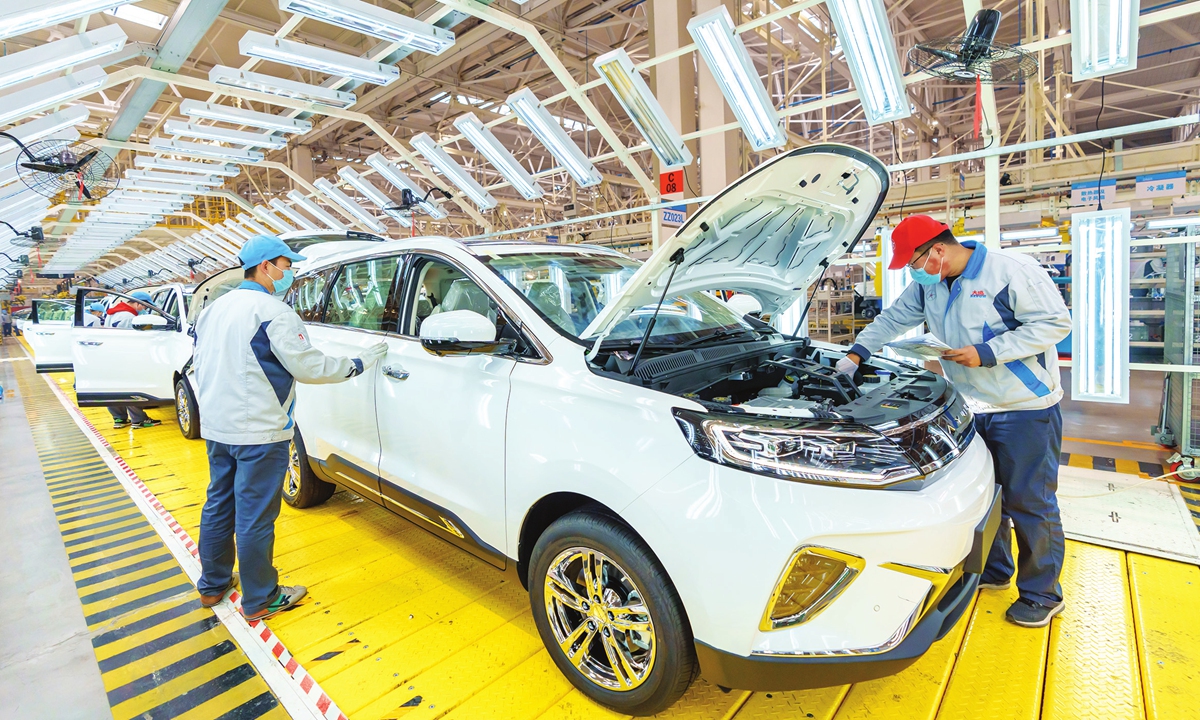
Employees assemble NEVs in a workshop in Yuncheng, North China's Shanxi Province on December 8, 2022. Photo: VCG
With the government's subsidies on new-energy vehicles (NEVs) phased out as scheduled, China's NEV market has ushered in a new stage marked by competition. It is time for industry players to improve their core competitiveness by reducing costs and launching innovative products that satisfy the needs of Chinese consumers.
China's leading NEV manufacturer BYD (Build Your Dreams) said that it will adjust its selling prices starting from Sunday. Official guidance prices of some BYD models will rise by between 2,000 yuan ($290) and 6,000 yuan per vehicle, the company said on Saturday.
The Shenzhen-based auto manufacturer actually announced the price adjustment at the end of November, citing the expiration of the governmental subsidy policy, and the price hikes of battery-making materials.
Separately, Aion, an NEV marque under Guangzhou Automobile Group, said in December that it will raise selling price of its models by 3,000 yuan to 8,000 yuan, citing the withdrawal of the subsidies and rising material prices.
Different from the two NEV makers' pricing strategy, other manufacturers choose to absorb the costs caused by the phase-out of government subsidies.
"With the withdrawal of incentives, it will add cost pressure on automakers. So it is natural for the NEV makers to raise prices. However, considering Tesla's recent price cuts, most NEV companies may maintain price stability and not make too drastic price adjustments," Cui Dongshu, the secretary general of the China Passenger Car Association (CPCA), told the Global Times on Monday.
In the fourth quarter of 2022, Tesla announced price reduction, followed by a limited-time insurance subsidy, so as to eliminate consumers' concerns about rising costs.
New stage coming
During the three-day New Year holidays, the company launched fresh promotional activities. "If customers place order by the end of February, they could enjoy insurance subsidy of 4,000 yuan and cash subsidy of 6,000 yuan," a Tesla salesperson in Beijing told the Global Times on Monday.
"Now that the supply chain cost remains elevated, plus the pull-back of government subsidies, but we choose to digest the costs by ourselves," the salesperson said. The price of lithium carbonate, a key component for NEV battery, is expected to drop in 2023, offering some relief for NEV makers.
Morgan Stanley forecast that Chinese lithium carbonate prices at $67,500 per ton in the first half of 2023, falling to $47,500 per ton in the second half of 2023.
China started to phase out the NEV purchase incentive at the end of 2022. In 2022, the government granted a relatively smaller subsidy to NEV buyers, with pure-electric and plug-in hybrid vehicles eligible for subsidies of 12,600 yuan and 4,800 yuan per unit, respectively.
China's NEVs include pure electric, plug-in hybrid and hydrogen fuel-cell vehicles.
The subsidy scheme was first introduced in 2009 to help cultivate China's nascent NEV sector to develop faster. The government had announced plans in 2015 to end subsidies by the end of 2020, although that deadline was prolonged in March 2020, to blunt the impact of the COVID pandemic which acutely weakened consumer demand for vehicles.
With the expiration of governmental subsidies, China's NEV industry will embrace a new stage to be marked by increased market competition, and only those players which could provide market-needed products will survive and thrive, analysts say.
Market competition However, for the country's major NEV manufacturers, subsidy has already become an increasingly minor consideration during recent years, as the NEV industry has become more market-driven.
The ratio of NEVs that obtained governmental subsidies has dropped from 78 percent in 2017 to 47 percent in 2021, data from the Ministry of Industry and Information Technology showed.
"The phase-out of subsidies will have a big impact on those auto players that make cars for subsidy's sake, and on those models that are mainly low end, priced around 100,000 yuan," Cui said.
"China's NEV market has become much more mature compared with a decade ago, with NEV models more acceptable among Chinese consumers," he added.
From January to November of 2022, the country's NEV sales exceeded 6.06 million units, doubling from the previous year. And the market share of NEVs has hit 25 percent, according to the China Association of Automobile Manufacturers (CAAM).
Analysts projected there will be slower EV sales in the coming months after the subsidy policy phase-out, but its sales growth will still remain positive in the country in 2023.
The CAAM forecast that China's NEV sales for 2023 will likely rise by 35 percent in the coming 12 months to reach 9 million units, compared to an estimated 6.7 million units for 2022.
Zhang Xiang, visiting professor with the Engineering Department of Huanghe Science and Technology University, predicted that NEV sales growth will edge down in 2023 due to the phase-out of the subsidy policy. But Chinese market enthusiasm for NEVs will last.
He predicted that NEVs will likely account for 30 percent of all vehicle sales in the country in 2023 - the highest among all major economies in the world.
And, NEV market competition is to intensify in 2023, especially among the carmakers and dealers, according to an analysis by the Great Wall Securities.




